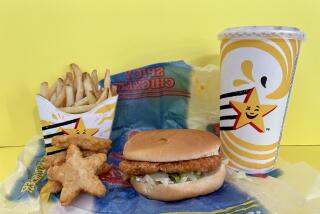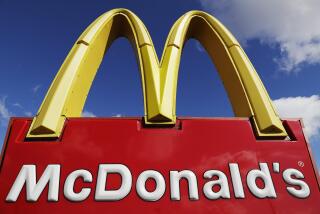Wendyâs Finds Value by Sticking to Its Flagship Fare
While McDonaldâs Corp. and other burger chains have slugged it out with 99-cent Big Macs and 49-cent hamburgers, Wendyâs International Inc., the company best known for its square hamburgers, has stayed out of the fray, keeping its profit and the reputation it claims for quality intact.
The Dublin, Ohio-based company, which has generated strong sales by offering generally pricier fare than competitors, has rejected the margin-killing strategy of heavy discounting rampant in the fast-food industry. Slashing prices can cheapen the value of products over time in consumersâ minds and even tarnish a companyâs image, Wendyâs Chief Executive Jack T. Schuessler said.
Price-cutting also can trigger never-ending price wars, said John Glass, an analyst at CIBC World Markets in Boston. âOnce you start discounting, you canât get out of that vicious cycle,â he said.
Wendyâs has not ignored the value-conscious consumer. Rather than slash the price of its flagship burgers as McDonaldâs does, it offers a 99-cent menu featuring chili, shakes and other items that can be sold profitably discounted, experts said.
Because Wendyâs value menu has changed little in 13 years, customers are not confused by constantly falling or rising prices as they are at other restaurants, Morningstar analyst Harry Milling said.
But Wendyâs appears most interested in reaching a slightly more affluent and older customer who is willing to pay for perceived quality.
Such a strategy has boosted Wendyâs market share for five consecutive years. The companyâs five-year annual earnings growth rate of nearly 10% dwarfs McDonaldâs 3.7%.
Despite its gains, Wendyâs market share, which is at 13.2%, up from 12.7% in 2000, continues to trail Burger Kingâs and lags far behind McDonaldâs 43.1%, said Dennis Lombardi of Technomic Inc., a restaurant research and consulting firm in Chicago.
And, like its big burger rivals, the chain faces several challenges, including so-called âburger burnoutâ and the increased competition from new fast-casual chains, which combine the speed of fast food with the quality of a casual dining chain.
Unlike its rivals, Wendyâs uses fresh ground beef. That commitment to quality has helped it to consistently rate higher than McDonaldâs and Burger King in a national taste survey, said Bob Sandelman of Sandelman & Associates, the Villa Park restaurant consulting firm that conducted the study.
âItâs all about the food,â Wendyâs CEO Schuessler said.
The typical Wendyâs customer spends about $4.75 per visit, CIBC analyst Glass said. That compares with $4.25 at McDonaldâs, $4.20 at Jack in the Box and $3.50 at Burger King, according to Technomic.
Wendyâs successful pricing policy has spawned at least one imitator. Burger King, the nationâs No. 2 burger chain, no longer discounts its flagship burger, the Whopper.
Wendyâs attempts to go more upscale helped to boost same-store sales by a strong 7.3% in June and 6.6% in the second quarter. Profit jumped 14% to nearly $64 million, or 54 cents a share, on sales of $684 million.
âPeople go there and keep going back,â Standard & Poorâs analyst Dennis Milton said.
Reflecting Wall Streetâs faith in Wendyâs, the companyâs stock has appreciated by 24% in the last year. Shares closed down $1.89 at $33.87on Friday on the New York Stock Exchange.
In an effort to move the chain beyond its fast-food roots and diversify into faster-growing concepts, Wendyâs has been on a spending spree of late.
In February, the chain made its first foray into the fast-casual arena by investing $10 million for a 45% stake in Cafe Express, a Houston-based chain of 13 restaurants. The company hopes to grow the concept to 50 restaurants within three to five years.
Last month, Wendyâs agreed to buy the parent company of Thousand Oaks-based Baja Fresh Mexican Grill for $275 million in cash. The company hopes to expand Baja Fresh to as many as 700 restaurants in five years, from 173 today. Baja Fresh, known for its homemade salsas and burritos, is considered by many to be the star in the fresh Mexican sector.
Wendyâs has hinted that acquisitions would play an increasingly important role to help meet its annual profit goal of 12% to 15% growth over the next decade. So far, analysts have applauded Wendyâs moves, including the 1995 takeover of Tim Hortons, its 2,200-unit chain that controls 70% of the coffee and baked goods restaurant market in Canada.
But the strategy of growing profit and sales by gobbling up competitors is fraught with risk, said Janet Lowder, president of Restaurant Management Services in Rancho Palos Verdes. Acquisitions often are difficult to digest, and they can divert managementâs attention from running core businesses if any problems surface. If Wendyâs moves too quickly, the company could saddle itself with a mountain of debt and high interest payments, just as CKE Restaurants Inc. did when it acquired Hardeeâs four years ago for about $760 million.
Schuessler said Wendyâs would expand cautiously.
As it positions itself for the future, Wendyâs is looking backward. The company, which profited for so long from late founder Dave Thomasâ folksy charm, has brought him back with new television commercials that say the food is prepared âDaveâs way.â
âDave is ingrained in this companyâs values and culture,â Schuessler said. âThere was such an outpouring of emotion when he died that we decided to subtly link [him] to the brand and food.â
More to Read
Inside the business of entertainment
The Wide Shot brings you news, analysis and insights on everything from streaming wars to production â and what it all means for the future.
You may occasionally receive promotional content from the Los Angeles Times.










